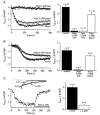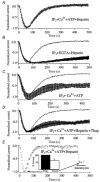An examination of the secretion-like coupling model for the activation of the Ca2+ release-activated Ca2+ current I(CRAC) in RBL-1 cells
- PMID: 11283225
- PMCID: PMC2278514
- DOI: 10.1111/j.1469-7793.2001.0055g.x
An examination of the secretion-like coupling model for the activation of the Ca2+ release-activated Ca2+ current I(CRAC) in RBL-1 cells
Abstract
One popular model for the activation of store-operated Ca2+ influx is the secretion-like coupling mechanism, in which peripheral endoplasmic reticulum moves to the plasma membrane upon store depletion thereby enabling inositol 1,4,5-trisphosphate (InsP3) receptors on the stores to bind to, and thus activate, store-operated Ca2+ channels. This movement is regulated by the underlying cytoskeleton. We have examined the validity of this mechanism for the activation of I(CRAC), the most widely distributed and best characterised store-operated Ca2+ current, in a model system, the RBL-1 rat basophilic cell line. Stabilisation of the peripheral cytoskeleton, disassembly of actin microfilaments and disaggregation of microtubules all consistently failed to alter the rate or extent of activation of I(CRAC). Rhodamine-phalloidin labelling was used wherever possible, and revealed that the cytoskeleton had been significantly modified by drug treatment. Interference with the cytoskeleton also failed to affect the intracellular calcium signal that occurred when external calcium was re-admitted to cells in which the calcium stores had been previously depleted by exposure to thapsigargin/ionomycin in calcium-free external solution. Application of positive pressure through the patch pipette separated the plasma membrane from underlying structures (cell ballooning). However, I(CRAC) was unaffected irrespective of whether cell ballooning occurred before or after depletion of stores. Pre-treatment with the membrane-permeable InsP3 receptor antagonist 2-APB blocked the activation of I(CRAC). However, intracellular dialysis with 2-APB failed to prevent I(CRAC) from activating, even at higher concentrations than those used extracellularly to achieve full block. Local application of 2-APB, once I(CRAC) had been activated, resulted in a rapid loss of the current at a rate similar to that seen with the rapid channel blocker La3+. Studies with the more conventional InsP3 receptor antagonist heparin revealed that occupation of the intracellular InsP3-sensitive receptors was not necessary for the activation or maintenance of I(CRAC). Similarly, the InsP3 receptor inhibitor caffeine failed to alter the rate or extent of activation of I(CRAC). Exposure to Li+, which reduces InsP3 levels by interfering with inositol monophosphatase, also failed to alter I(CRAC). Caffeine and Li+ did not affect the size of the intracellular Ca2+ signal that arose when external Ca2+ was re-admitted to cells which had been pre-exposed to thapsigargin/ionomycin in Ca2+-free external solution. Our findings demonstrate that the cytoskeleton does not seem to regulate calcium influx and that functional InsP3 receptors are not required for activation of I(CRAC). If the secretion-like coupling model indeed accounts for the activation of I(CRAC) in RBL-1 cells, then it needs to be revised significantly. Possible modifications to the model are discussed.
Figures








References
-
- Berridge MJ, Lipp P, Bootman MD. The calcium entry Pas de Deux. Science. 2000;287:1604–1605. - PubMed
-
- Boulay G, Brown DM, Qin N, Jiang M, Dietrich A, Xi M, Chen Z, Birnbaumer M, Mikoshiba K, Birnbaumer L. Modulation of Ca2+ entry by polypeptides of the inositol 1,4,5-trisphosphate receptor (IP3R) that bind transient receptor potential (TRP): Evidence for roles of TRP and IP3R in store depletion-activated Ca2+ entry. Proceedings of the National Academy of Sciences of the USA. 1999;96:14955–14960. - PMC - PubMed
-
- Bubb MR, Senderowicz AM, Sausville EA, Duncan KL, Korn ED. Jasplakinolide, a cytotoxic natural product, induces actin polymerisation and competitively inhibits the binding of phalloidin to F-actin. Journal of Biological Chemistry. 1994;269:14869–14871. - PubMed
-
- Cancela JM, Gerasimenko OV, Gerasimenko JV, Tepikin AV, Petersen OH. Two different but converging messenger pathways to intracellular Ca2+ release: the roles of nicotinic acid adenine dinucleotide phosphate, cyclic ADP-ribose and inositol trisphosphate. EMBO Journal. 2000;19:2549–2557. - PMC - PubMed
Publication types
MeSH terms
Substances
Grants and funding
LinkOut - more resources
Full Text Sources
Miscellaneous

